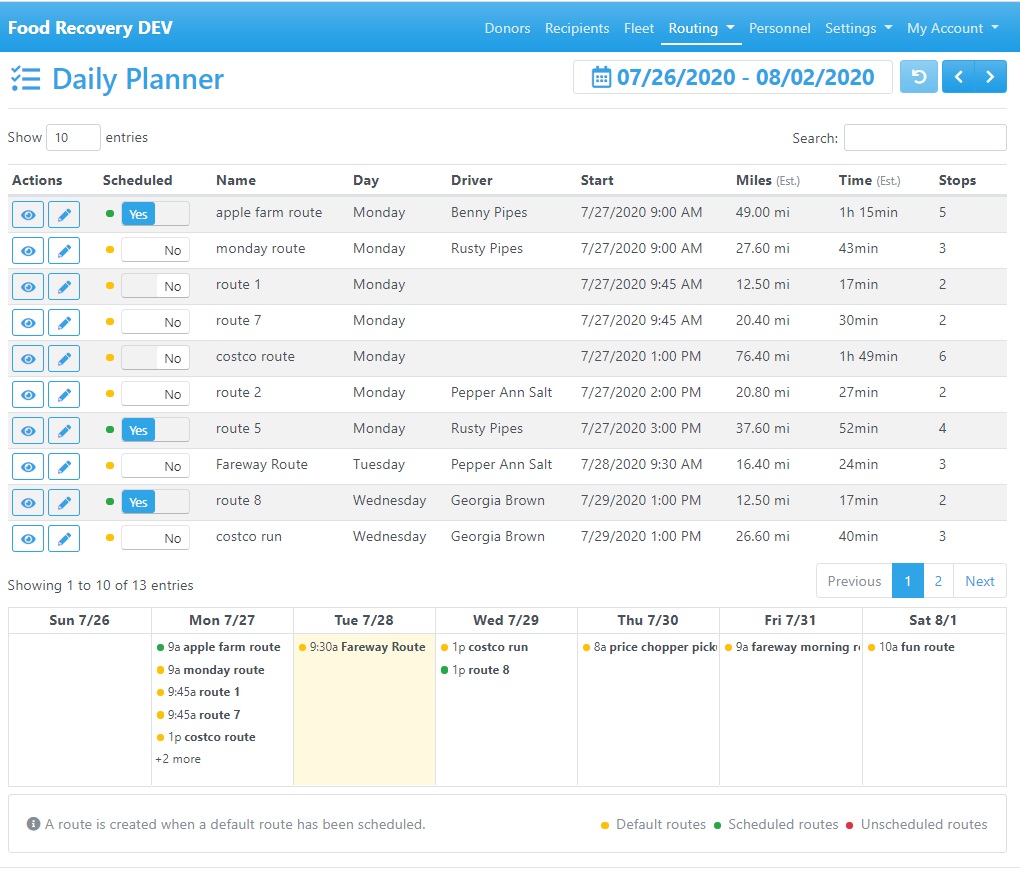A screenshot shows the food recovery platform’s Daily Route Planner, which food insecurity nonprofits will use to manage drivers and routes of food pickup and deliveries. This platform is in development, and the final portal design is subject to change.
Screenshots provided by Polk County IT Department
Can food insecurity be addressed through a software program? With custom software created for area nonprofits, Polk County’s information technology department is developing the answer.
Tasked by the Polk County Board of Supervisors in early summer 2019, Polk County developers began studying up to 15 nonprofits addressing food insecurity and hunger in the county to learn how they communicated with each other and with volunteers. The application is funded by Polk County, and may launch in an initial phase later this summer or early fall for county organizations.
“This food insecurity issue is of high importance for every member of the Board of Supervisors, so this is basically a directive to us to help in solving the problem,” said Daniel Radkey, senior application developer for Polk County.
Organizations in the county have long known that pen-and-paper tracking by individual nonprofits has not been able to account for all the data that organizations are managing during regular operations.
Developing a shared digital platform would allow multiple organizations across the metro to log pounds of food that is donated or “rescued” from food donors — grocery stores, restaurants, gas stations, caterers or other entities with overstock food — and then transported to recipients, such as food pantries, community programs, churches or other locations that then provide the food to families or individuals.
“The whole idea is to have more voices, not less — to have more organizations involved, not less,” Radkey said. “So instead of building a single program, or a single application for a single program … we decided to go the platform route, which means that all of the individual programs that are participating in food recovery can utilize the software, which empowers them to track the routing, the sorting and the logging of food from the various stopping points.”
In mid-July, task force members on the Greater Des Moines Food Rescue Network got an updated walk-through of the product, which at press time had not been officially branded.
Representing multiple nonprofits running food insecurity programs, task force members followed along on Zoom as Jason Monroe, senior business analyst for Polk County IT and project lead, demonstrated the platform’s route-planning maps and vehicle fleet inventory process.
Logging food collected and distributed by the many organizations and their volunteers remains a logistical challenge for the development team to solve: While some organizations have the ability to plan for and store excess food donations in warehouses, others, like Eat Greater Des Moines, don’t have those facilities, and rely on giving away all the donations they receive in each route pickup and delivery.
“We need them to be able to build routes and have vehicles on those routes, we need them to be able to log the food they have at stops,” Monroe said. “Beyond that, you have to decide what’s a fresh coat of paint on something versus what is real functionality that will go beyond.”
Collaboration between nonprofits has also been limited by staff and volunteers’ ability to share data between organizations, and existing software on the market didn’t meet the needs of Polk County organizations, Radkey said.
The web-based application’s tracking features could ultimately shed light on more efficient routes for partners in the metro network. The initial launch will allow individual programs to manage and maintain a list of donors, manage personnel and volunteers, manage pickup and delivery routes, and log the amount of food collected and distributed.
A future second phase of the platform will allow donors and recipients to log into the platform to download reports and update their own operating details in the network, Radkey said. The development team also plans to introduce Android and iOS applications.
“Everything that we’re currently working on delivery is only for the management of the nonprofit. We have not gone down the route of creating any portals for donors and recipients yet for them to log in, [but] that is definitely down the pipe for us,” Monroe said.
“This is a niche market, something that wouldn’t necessarily be built within the private sector since there isn’t necessarily a profit motive to this,” Radkey said. “If you were to attempt to wrap your arms around the problem, these data points haven’t been readily available to address the need of the problem … [and] having these metadata points is the first step in truly addressing the food insecurity problem.”
The county has developed its own software applications since 2010, and this application is designed to scale over time as more organizers join the platform.
“As the programs that participate grow, the application is built to accommodate that level of growth,” Radkey said. “This application is not limited to just Polk County. We can actually scale this out to Dallas County and Story County, and all the various other counties and even statewide applications as well. We’re able to grow this beyond just the scope of the needs of Polk County.”
“We’re passionate about solving the problem, and developing a product to serve Polk County,” Radkey said.
Iowa Stops Hunger is a yearlong Business Publications Corp. initiative to bring awareness and action to food insecurity in Iowa.
